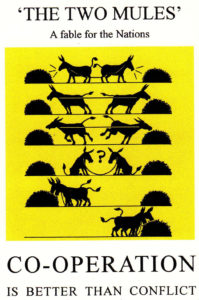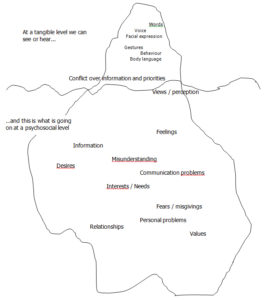| Exercise, handout number |
Time |
Method |
Materials |
| Opening session |
15 min |
Recap of feedback rules and repeating of phase 1 |
|
| Checklist for observers |
5 min |
Plenary |
Copy |
| Checklist of a mediation role play |
5 min |
Plenary |
Copy |
| Phase 2: Viewpoints and issues –Role play 1+2 |
40 min |
Phase 2: Viewpoints and issues –Role play 1+2 (HO 16) |
Role play cards
Copy |
| Quit the role of the play |
5 min |
Plenary: importance of quitting the role, let´s shake the body |
|
| Evaluation of the role play |
10 min |
Plenary: sharing of the observers of the different groups |
|
| Energizer |
10 min |
|
|
| Evaluation |
10 min |
Plenary |
|
Handout 14: Checklist for observers of role plays
Observers of a mediation role play take notes of the process and contribute constructive feedback during the reflection phase. Observers concentrate on:
Concerning the mediators:
The phases of the mediation
- Appropriate, helpful moderation of the phases?
- Was anything left out or neglected/forgotten?
- Could anything improve the moderation?
Body language and impartiality of the mediators
- Were the mediators able to express interest in the parties by body language
- Were both parties equally considered (eye contact, open, friendly body language)?
- Did both parties get an equal share of contributions?
Helpful remarks/ questions
- What were helpful, opening phrases or questions?
Concerning the participating parties
- Did you have the feeling that the parties were able to express their point of view?
- What kind of behavior did you notice (parties opening up, showing feelings, becoming angry etc.)?
- Did you observe that the parties were able to take a change of perspectives?
- Anything else?
Handout 15: Worksheet: Evaluation of a mediation role play
After the mediation role play the trainer moderates the evaluation.
Firstly, the mediators are asked:
- What went well during the mediation role play? Do you have the feeling that you were able to support the process?
- Did you feel insecure at any time during the process?
- What was difficult? What would you like to improve?
Secondly, the parties are asked:
- How do you feel now? Has the conflict been solved?
- What were helpful interventions/ phrases?
- Did you feel understood by the mediators?
- Anything else, you would like to mention, e.g. ideas how the mediators could have supported you more?
Thirdly, the observers give feedback.
After the evaluation the trainer asks the participants to let go of the role, e.g. by taking of the name tags and actively stepping out of the role.
The group collects difficult situations during the role play on a flipchart and discusses possible alternatives.
Hanouts 16: Viewpoints and issues: How does each party view the conflict?
Who begins?
The mediators ask the parties who wants to begin explaining his/her point of view. Sometimes it makes sense to ask the less active person to begin, in some cases when the parties cannot agree who can talk first to throw a coin.
The parties take turns explaining their viewpoints and issues
The parties have the chance to describe their points of view and are supported by the mediators by using the following skills:
Repeat, summarize and ask (Active listening)
The mediators repeat the crucial points and summarize what has been said. Anything they didn´t understand should be questioned again in order to make sure that they understand the parties point of view. (E.g. Can you please explain … again? or I didn´t fully understand … or From your point of view … happened. Am I right or did I misunderstand?)
Mediators pay attention that the rules are adhered to
Mediators have to insist that the rules of communication are respected, e.g. not to interrupt each other or to call each other names.
“Please wait a second until it is your turn.”
“No name calling during the mediation, we all agreed to accept this rule.”
In a case of a heated situation where the parties have difficulties to calm down, it can be helpful to ask the students to turn around and not look at each other for a while. Another option is to work with a yellow and a red card (similar to the rules of a soccer game).
Emphasize what the parties have in common and where they differ
Summarize their interests and feelings in order to clarify similarities and differences.
“I understood that both of you…”
“You have a different point of view/ opinion concerning …”
“Both of you want to…”
 |
Source:
- Jamie Walker (Ed.), Mediation in der Schule 2005, p. 185, revised by Beate Roggenbuck
|










